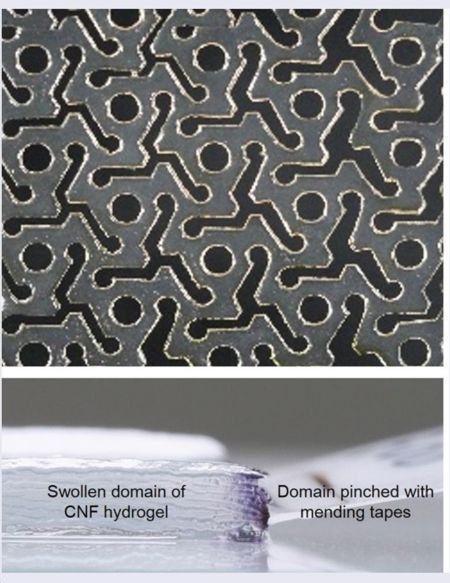TSUKUBA، جاپان، 12 اپریل 2024 – (ACN نیوز وائر) – New options for making finely structured soft, flexible and expandable materials called hydrogels have been developed by researchers at Tokyo University of Agriculture and Technology (TUAT). Their work extends the emerging field of ‘kirigami hydrogels’, in which patterns are cut into a thin film allowing it to later swell into complex hydrogel structures. The research is published in the journal Science and Technology of Advanced Materials.

Hydrogels have a network of water-attracting (hydrophilic) molecules, allowing their structure to swell substantially when exposed to water that becomes incorporated within the molecular network. Researchers Daisuke Nakagawa and Itsuo Hanasaki worked with an initially dry film composed of nanofibers of cellulose, the natural material that forms much of the structure of plant cell walls.
They used laser processing to cut structures into the film before water was added allowing the film to swell. The particular design of the Kirigami pattern works in such a way that the width increases when stretched in the longitudinal direction, which is called the auxetic property. This auxetic property emerges provided that the thickness grows sufficiently when the original thin film is wet.
“As Kirigami literally means the cut design of papers, it was originally intended for thin sheet structures. On the other hand, our two-dimensional auxetic mechanism manifests when the thickness of the sheet is sufficient, and this three dimensionality of the hydrogel structure emerges by swelling when it is used. It is convenient to store it in the dry state before use, rather than keeping the same water content level of the hydrogel.” says Hanasaki. “Furthermore, the auxeticity is maintained during the cyclic loading that causes the adaptive deformation of the hydrogel to reach another structural state. It will be important for the design of intelligent materials.”
Potential applications for the adaptive hydrogels include soft components of robotic technologies, allowing them to respond flexibly when interacting with objects they are manipulating, for example. They might also be incorporated into soft switches and sensor components. Hydrogels are also being explored for medical applications, including tissue engineering, wound dressings, drug delivery systems and materials that can adapt flexibly to movement and growth. The advance in kirigami hydrogels achieved by the TUAT team significantly extends the options for future hydrogel applications.
“Keeping the designed characteristics while showing adaptivity to the environmental condition is advantageous for the development of multifunctionality,” Hanasaki concludes.
مزید معلومات
Itsuo Hanasaki
ٹوکیو یونیورسٹی آف ایگریکلچر اینڈ ٹیکنالوجی
Email: hanasaki@cc.tuat.ac.jp
کاغذ: https://doi.org/10.1080/14686996.2024.2331959
سائنس اور ٹیکنالوجی کے اعلی درجے کے مواد کے بارے میں (STAM)
اوپن ایکسیس جرنل STAM میٹریل سائنس کے تمام پہلوؤں پر شاندار تحقیقی مضامین شائع کرتا ہے، بشمول فنکشنل اور ساختی مواد، نظریاتی تجزیہ، اور مواد کی خصوصیات۔ https://www.tandfonline.com/STAM
ڈاکٹر یاسوفومی ناکامیچی
STAM پبلشنگ ڈائریکٹر
ای میل: NAKAMICHI.Yasufumi@nims.go.jp
پریس ریلیز ایشیا ریسرچ نیوز فار سائنس اینڈ ٹیکنالوجی آف ایڈوانسڈ میٹریلز کے ذریعے تقسیم کی گئی۔
عنوان: پریس ریلیز کا خلاصہ
ماخذ: جدید مواد کی سائنس اور ٹیکنالوجی
سیکٹر: کیمیکل، Spec.Chem, سائنس اور نینوٹیک
https://www.acnnewswire.com
ایشیاء کارپوریٹ نیوز نیٹ ورک سے
حق اشاعت © 2024 اے سی این نیوزوائر۔ جملہ حقوق محفوظ ہیں. ایشیا کارپوریٹ نیوز نیٹ ورک کا ایک ڈویژن۔
- SEO سے چلنے والا مواد اور PR کی تقسیم۔ آج ہی بڑھا دیں۔
- پلیٹو ڈیٹا ڈاٹ نیٹ ورک ورٹیکل جنریٹو اے آئی۔ اپنے آپ کو بااختیار بنائیں۔ یہاں تک رسائی حاصل کریں۔
- پلیٹوآئ اسٹریم۔ ویب 3 انٹیلی جنس۔ علم میں اضافہ۔ یہاں تک رسائی حاصل کریں۔
- پلیٹو ای ایس جی۔ کاربن، کلین ٹیک، توانائی ، ماحولیات، شمسی، ویسٹ مینجمنٹ یہاں تک رسائی حاصل کریں۔
- پلیٹو ہیلتھ۔ بائیوٹیک اینڈ کلینیکل ٹرائلز انٹیلی جنس۔ یہاں تک رسائی حاصل کریں۔
- ماخذ: https://www.acnnewswire.com/press-release/english/90245/
- : ہے
- 12
- 2024
- 350
- 7
- a
- AC
- تک رسائی حاصل
- حاصل کیا
- ACN
- اے سی این نیوزوائر۔
- acnnewswire
- کے پار
- اپنانے
- انکولی
- شامل کیا
- آگے بڑھانے کے
- اعلی درجے کی
- جدید ترین مواد
- فائدہ مند
- زراعت
- تمام
- اجازت دے رہا ہے
- بھی
- an
- تجزیہ
- اور
- ایک اور
- ایپلی کیشنز
- اپریل
- کیا
- مضامین
- ایشیا
- پہلوؤں
- At
- BE
- ہو جاتا ہے
- رہا
- اس سے پہلے
- کیا جا رہا ہے
- پایان
- by
- کہا جاتا ہے
- کر سکتے ہیں
- وجوہات
- سیل
- خصوصیات
- COM
- پیچیدہ
- اجزاء
- پر مشتمل
- اختتام
- شرط
- رابطہ کریں
- مواد
- آسان
- کارپوریٹ
- کارپوریٹ نیوز
- کٹ
- ترسیل
- ڈیزائن
- ڈیزائن
- ترقی یافتہ
- ترقی
- سمت
- تقسیم کئے
- ڈویژن
- منشیات کی
- خشک
- کے دوران
- ابھرتا ہے
- کرنڈ
- آخر
- انجنیئرنگ
- ماحولیاتی
- مثال کے طور پر
- قابل توسیع
- وضاحت کی
- ظاہر
- توسیع
- میدان
- فلم
- لچکدار
- نرمی سے
- کے لئے
- فارم
- سے
- فنکشنل
- مستقبل
- Go
- بڑھتا ہے
- ترقی
- ہاتھ
- ہے
- HTTP
- HTTPS
- تصویر
- اہم
- in
- شامل
- سمیت
- شامل
- اضافہ
- ابتدائی طور پر
- انٹیلجنٹ
- ارادہ
- بات چیت
- میں
- IT
- جاپان
- جرنل
- jp
- فوٹو
- رکھتے ہوئے
- لیزر
- بعد
- سطح
- لوڈ کر رہا ہے
- برقرار رکھا
- بنانا
- جوڑ توڑ
- مواد
- مواد
- کا مطلب ہے کہ
- میکانزم
- طبی
- طبی درخواستیں
- شاید
- آناخت
- تحریک
- بہت
- قدرتی
- نیٹ ورک
- خبر
- نیوز وائر
- اشیاء
- of
- on
- آپشنز کے بھی
- اصل
- اصل میں
- دیگر
- ہمارے
- بقایا
- کاغذات
- خاص طور پر
- پاٹرن
- پیٹرن
- پلاٹا
- افلاطون ڈیٹا انٹیلی جنس
- پلیٹو ڈیٹا
- پریس
- ریلیز دبائیں
- پروسیسنگ
- خصوصیات
- جائیداد
- فراہم
- شائع
- شائع کرتا ہے
- پبلشنگ
- بلکہ
- تک پہنچنے
- جاری
- تحقیق
- ریسرچ نیوز
- محققین
- محفوظ
- جواب
- حقوق
- اضافہ
- اسی
- کا کہنا ہے کہ
- سائنس
- سائنس اور ٹیکنالوجی
- سینسر
- شیٹ
- ظاہر
- نمایاں طور پر
- سافٹ
- حالت
- ذخیرہ
- ساختی
- ساخت
- منظم
- ڈھانچوں
- کافی
- اس طرح
- کافی
- سسٹمز
- ٹیم
- ٹیکنالوجی
- ٹیکنالوجی
- سے
- کہ
- ۔
- ان
- ان
- نظریاتی
- وہ
- پتلی
- اس
- تین
- کرنے کے لئے
- ٹوکیو
- سب سے اوپر
- یونیورسٹی
- استعمال کی شرائط
- استعمال کیا جاتا ہے
- تھا
- پانی
- راستہ..
- گیلا
- جب
- جس
- جبکہ
- چوڑائی
- گے
- ساتھ
- کے اندر
- کام
- کام کیا
- کام کرتا ہے
- زیفیرنیٹ












